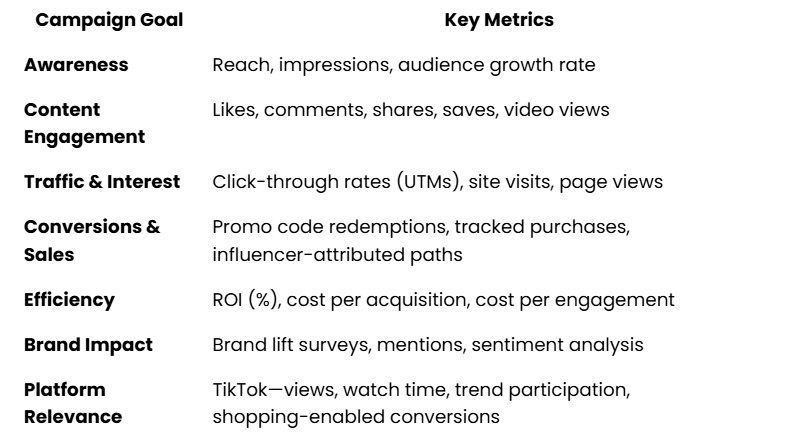As more brands expand into influencer marketing, the question arises: “how should you measure success in this new channel?”
When it comes to influencer marketing, "ROI" isn't just about sales—or even simple reach. It's about understanding what success looks like for your unique campaign goals and choosing the right metrics to reflect that.
Influencer marketing is here to stay as it continues to dominate on platforms like Instagram and TikTok. 58% of consumers now have TikTok profiles, and 82% of Gen-Z users are on the platform according to Sprout Social. Additionally, 36% of social-driven direct purchases occur on TikTok, making it a proven commerce-enabled medium.
Once you’ve decided it’s time for your brand to launch an influencer campaign, here are the metrics that truly matter when evaluating success.
Key Metrics Across the Funnel
According to the Digital Marketing Institute, six essential KPIs to track for an influencer campaign are: traffic, engagement, conversions, brand awareness and sentiment, audience growth rate, and ROI (source: Digital Marketing Institute).
Traffic (such as clicks and page visits) shows intent, while engagement (likes, saves, comments, shares) reflects content resonance—especially crucial for influencer marketing.
Influencer Marketing Hub also groups success metrics into similar categories: immediate campaign metrics, ROI & sales-related metrics, and brand awareness & sentiment metrics (source: Influencer Marketing Hub).
Immediate metrics: Reach, engagement, click-throughs
ROI/sales-related metrics: Conversions, sales value, cost per acquisition
Brand awareness & sentiment: Surveys, mentions, sentiment shifts
70% of marketers now measure ROI in influencer marketing campaigns, though about 13.6% still face challenges with measurement. (source: Influencer Marketing Hub).
At Revel Interactive, we work with our brands to determine KPIs aligned with brand goals as well as where the brand is in their stage of growth. Ie, for a growing D2C brand, we would hone in on Brand Awareness strategies.
Putting It All Together: The Metrics That Matter
How to Measure and Report Effectively
Align metrics to campaign objectives—set measurable KPIs upfront with the campaign objectives in mind.
Use tracking tools—use UTMs, affiliate links, promo codes, and analytics dashboards to monitor traffic and conversions.
Incorporate sentiment analysis—brand awareness surveys and social listening can uncover shifts in perception.
Benchmark and iterate—compare performance to past campaigns and industry benchmarks.
Final Thoughts
ROI in influencer marketing isn’t one-size-fits-all. It’s not enough to count likes or views. The real success comes from knowing what you want, selecting metrics that align with those objectives, and interpreting them in context—whether that's sales, long-term brand equity, or cultural relevance.
By blending campaign performance with strategic context, you’ll measure not just activity, but real impact.
Interested in launching a creator marketing campaign to complement your existing paid media strategy? Reach out to your Revel account manager to learn more about our creator offerings or reach out through on our website.
Sources:
- Digital Marketing Institute – 5 Essential KPIs for Your Influencer Marketing Campaign
- Influencer Marketing Hub – How to Measure Influencer Campaigns
- Sprout Social – TikTok Statistics & Insights
This blog was edited with the help of Claude AI.
Photo: © warrengoldswain from Getty Images Pro


